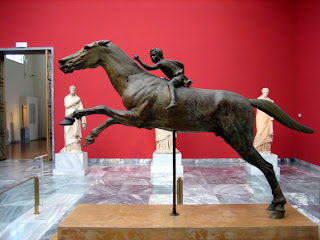EARLY BUDDHIST ART – ANICONIC PHASE
Buddhist art includes sculptures, paintings and other
art forms that represent the stories and concepts of Buddhism. The earliest
Buddhist art, which originated in India, was mostly symbolic and avoided
figurative depictions of the Buddha. Later, as Buddhism developed and spread to
a variety of cultures, its religous art came to represent the Buddha,
boddhisatvas, and gods in rich figurative imagery. Ritual art, such as the
intricate mandalas used in meditation, is also an important aspect of Buddhist
art.
The
Aniconic Phase of Buddhist Art took part in between the 5th century
and 1st century BCE. The first clear manifestations of Buddhist art date back
to the time of the emperor Ashoka during the Mauryan era (322-180 BCE), through
the building of numerous stupas, such as the one at Sanchi, and the erection of
pillars. The pillars were surmounted by animal capitals and decorated with
Buddhist symbols. Although Buddhism was born in India, which is a culture with
rich religious iconography, early Buddhist art avoided figurative
representations of the Buddha almost entirely. Instead he and his teachings
were represented by symbols, including:
- The Wheel of
law, symbol of the Four Noble Truths expressed by the Buddha.
- The Bodhi
tree, the tree where the Buddha reached enlightenment. It has some
antecedent in fertility cults and representations of the tree of life.
- The Buddha
footprint to represent the impact of the teachings of the Buddha on the
world.
- The Empty
throne.
- The Lions,
symbol of his royalty. The Buddha was known as the “Shakya Lion” during
Ashoka’s time, so this symbol was used on the Buddhist pillars he planted
throughout India.
- The Columns
surmounted by a wheel, symbol of his teaching.
- The Lotus,
symbol of pure, unspoiled Buddha Nature, for its beautiful blooming and
the impossibility for water to adhere to it, leaving it spotless.
This
reluctance towards anthropomorphic representations of the Buddha, and the
sophisticated development of aniconic symbols to avoid it (even in narrative
scene where other human figures would appear), seems to be connected to one of
the Buddha's sayings, reported in the Dighanikaya, that disfavored
representations of himself after the extinction of his body. This tendency
remained as late as the 2nd century CE in the Southern parts of India, in the
art of the Amaravati School. It has been argued that earlier anthropomorphic
representations of the Buddha may have been made of wood and may have perished
since then. However no related archaeological evidence has been found.
The Bodhi tree
The empty throne
The Buddha footprint
The Lions
The Lotus
The Wheel of Law









Comments
Post a Comment